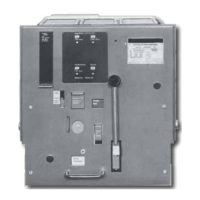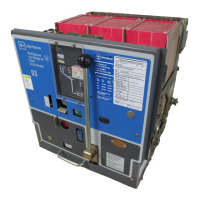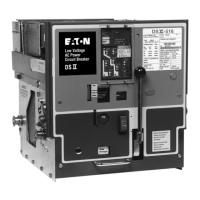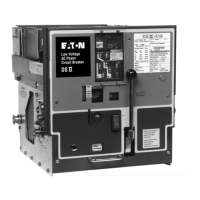27
Instruction Booklet IB 33-790-1J
Effective November 2010
Instructions for Low Voltage Power
Circuit Breakers Types DS and DSL
EATON CORPORATION www.eaton.com
The spring release latch can be rotated by two methods:
1. By the spring release device on power-operated
breakers, as shown in Figures 14 and 31b.
2. By the close bar, through the linkage shown in Figure
31b.
5.1.6 Circuit Breaker Tripping or Opening Mecha-
nism
Referring to Figure 22c showing the breaker in the closed
position, the breaker is tripped open by counterclockwise
rotation of the trip shaft. The trip shaft extends across the
left hand part of the breaker, f
rom the left hand mecha-
nism side sheet to the left hand breaker side sheet; and
can be rotated by several devices as later described.
Rotation of the trip shaft accomplishes breaker opening
as follows: Staying with Figure 22c, the main contacts
(not shown) produce a clockwise twisting force or torque
on the pole shaft. This is transmitted by the center pole
lever downward through the main drive link to the main
roller. The main drive link at the main roller is connect
ed
to the trip latch by the roller constraining link. The down-
ward force on the main drive link results in a pulling force
on the roller constraining link. This force tends to rotate
the trip latch counterclockwise, but the trip latch is kept
from rotating by overlap of the latch surface of the trip
shaft. A very small rotation of the trip shaft thus releases
the trip latch to rotate counterclockwise to the position
shown in Figure 22a. The enlarg
ed views of the trip shaft
and trip latch tip in Figure 22e show in detail the rotation
of the trip shaft for release of the trip latch. Thus the
entire linkage collapses under the force of the main con-
tacts and comes to rest with the breaker open, as in Fig-
ure 22a. Note that the trip latch is still in the released
position, i.e.: not reset.
If the breaker stands open with springs charged as in Fig-
ure 22b, and if the trip shaft is held in the rotated or tri
p
position, an attempt to close will result in a trip-free oper-
ation. This is so because, with the trip shaft in the trip
position, there is no restraint on the trip latch, so no force
is applied to the main link to close the breaker.
Although certain interlocking operations may or will result
in this trip-free type of operation, it causes some extra
shock on the mechanism parts. Therefore trip-free opera-
tions should be avoided.
Fig. 24 Actuator.

